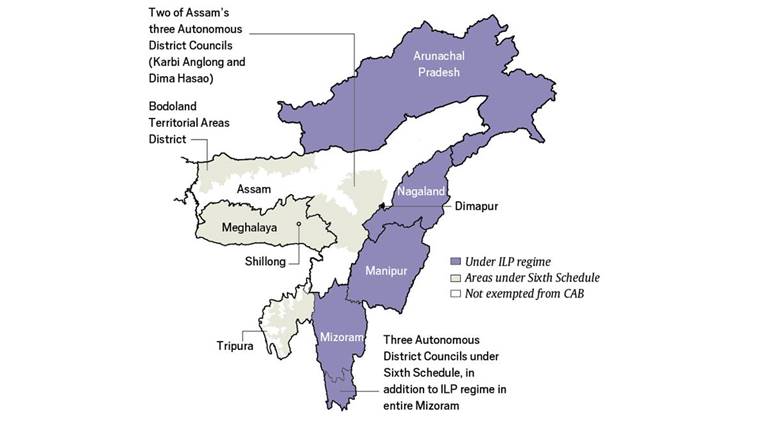There are two categories that have been given exemption — states
protected by the ‘Inner Line’, and areas covered under the Sixth
Schedule of the Constitution.
1)Inner Line Permit (ILP): This is a special permit that citizens from other parts of India require to enter a state protected by the ILP regime. Without an ILP granted by the state government, an Indian from another state cannot visit an state that is under the ILP regime
2)Sixth Schedule: The Sixth Schedule relates to special provisions in administration of certain Northeastern states. It provides special powers for Autonomous District Councils (ADCs) in these states. ADCs have powers to enact laws in areas under their jurisdiction on a variety of subjects, one of its objectives being to boost self-governance by tribal communities
Meghalaya: This state too has three ADCs. Unlike in Assam, the ADCs in Meghalaya cover almost the entire state. Only a small part of Shillong is not covered. CAB will be effective in that part of Shillong while the rest of the state is protected.
Tripura: One ADC covers around 70% of the state’s area. However, the remaining 30% holds about two-thirds of the population. CAB is effective in the smaller, more densely populated regions.
Arunachal Pradesh: Entire state covered under ILP regime, protected from CAB.
Nagaland: Entire state covered under ILP regime, protected from CAB. So far, only Dimapur used to be outside the regime. Now, ILP has been extended to Dimapur, too, so the whole state is now exempt.
Mizoram: Entire state covered under ILP regime, protected from CAB. Additionally, the state has three ADCs that are also protected under the Sixth Schedule.
Manipur: Entire state gets new ILP protection. The state was not protected under either option, but following the introduction of CAB in Parliament, the government has introduced ILP in Manipur too
1)Inner Line Permit (ILP): This is a special permit that citizens from other parts of India require to enter a state protected by the ILP regime. Without an ILP granted by the state government, an Indian from another state cannot visit an state that is under the ILP regime
2)Sixth Schedule: The Sixth Schedule relates to special provisions in administration of certain Northeastern states. It provides special powers for Autonomous District Councils (ADCs) in these states. ADCs have powers to enact laws in areas under their jurisdiction on a variety of subjects, one of its objectives being to boost self-governance by tribal communities
CAB 2019: State by state
Assam: The state has three Autonomous District Councils, two of which are geographically contiguous. While these are protected, CAB will be in effect in a larger area.Meghalaya: This state too has three ADCs. Unlike in Assam, the ADCs in Meghalaya cover almost the entire state. Only a small part of Shillong is not covered. CAB will be effective in that part of Shillong while the rest of the state is protected.
Tripura: One ADC covers around 70% of the state’s area. However, the remaining 30% holds about two-thirds of the population. CAB is effective in the smaller, more densely populated regions.
Arunachal Pradesh: Entire state covered under ILP regime, protected from CAB.
Nagaland: Entire state covered under ILP regime, protected from CAB. So far, only Dimapur used to be outside the regime. Now, ILP has been extended to Dimapur, too, so the whole state is now exempt.
Mizoram: Entire state covered under ILP regime, protected from CAB. Additionally, the state has three ADCs that are also protected under the Sixth Schedule.
Manipur: Entire state gets new ILP protection. The state was not protected under either option, but following the introduction of CAB in Parliament, the government has introduced ILP in Manipur too

No comments:
Post a Comment